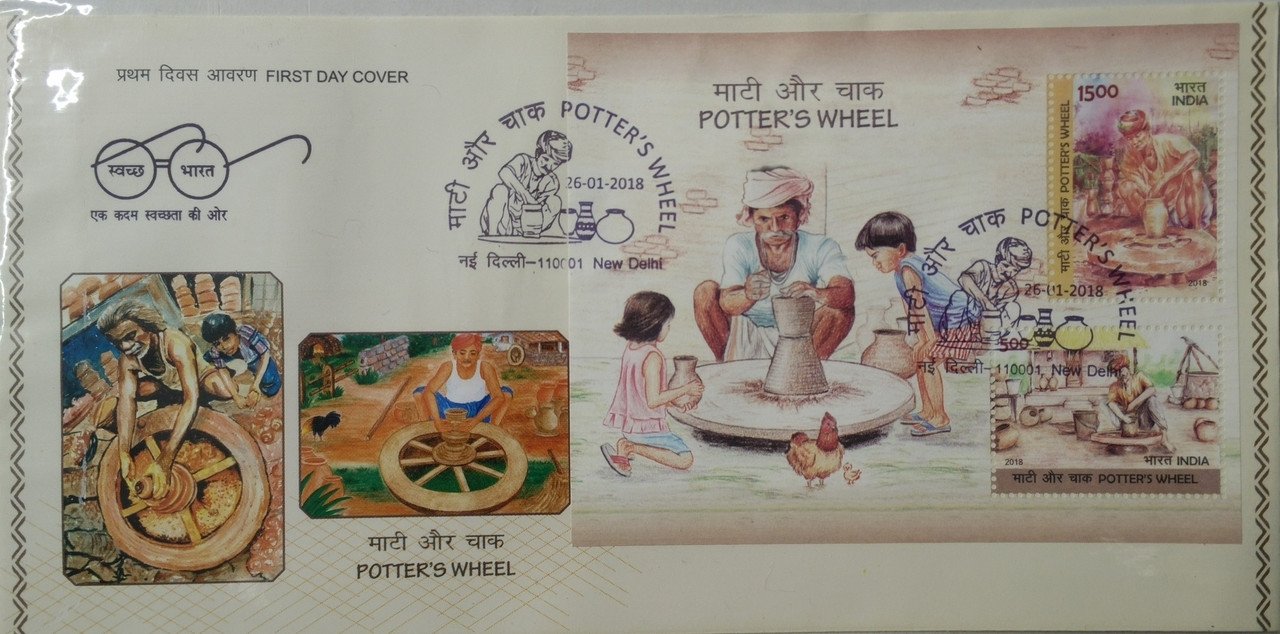Potter’s Wheel

Technical Data
| Date of Issue | January 26, 2018 |
|---|---|
| Denomination | Rs. 20 |
| Quantity | 110,000 |
| Perforation | 13¾ x 13¾ |
| Printer | Security Printing Press, Hyderabad |
| Printing Process | Wet Offset |
| Watermark | No Watermark |
| Colors | Multicolor |
| Credit (Designed By) | Ms. Nenu Gupta |
| Catalog Codes |
Michel IN BL187 Yvert et Tellier IN BF174 Stanley Gibbons IN MS3472 |
| Themes | Children | Crafts | Roosters and Chickens |
Potter’s Wheel – A Timeless Craft Celebrated Through Stamps
Every year, on the occasion of Republic Day, Independence Day, and Children’s Day, the Department of Posts organizes All India-level Stamp Design Competitions to encourage creativity and promote philately among citizens. Since 2015, these competitions have inspired artists of all ages to express national themes through art. The winning entries receive cash awards, and the selected designs are featured on postage stamps and other philatelic items.
This year, the Department conducted a stamp design competition on the theme “Potter’s Wheel.” Supported by 23 Postal Circle Offices across India, the competition received an enthusiastic nationwide response.
The Art of the Potter’s Wheel
Pottery, the age-old craft of shaping clay into beautiful and functional forms, stands among humanity’s earliest artistic and utilitarian expressions. Archaeological evidence reveals pottery dating back to 10,000 BC in Japan, marking one of the first signs of settled human life. As nomadic societies evolved into agrarian communities, the need for durable and stable containers gave birth to this enduring art form.
Early pottery was hand-built using the coiling technique, where clay was rolled into long threads and shaped by hand. The impressions of mats or leaves found on ancient pottery bases bear testimony to this early method, allowing artisans to rotate their creations without moving around them.
Over time, innovation led to the development of the potter’s wheel, which revolutionized ceramic making. The earliest wheels, known as tournettes or slow wheels, appeared around 4500 BC in the Near East. Turned slowly by hand or foot, they made the process more efficient and uniform.
By the mid to late 3rd millennium BC, the fast wheel was introduced, harnessing flywheel momentum to speed up production. This advancement gave rise to the art of “throwing”, where a lump of clay, placed at the centre of the spinning wheel, was shaped with the potter’s skilled hands. The resulting vessels were thinner, smoother, and more refined — paving the way for the industrialization of pottery-making.
The potter’s wheel remains a powerful symbol of creativity, balance, and transformation — where simple clay, guided by human touch and motion, takes on a form of timeless beauty.
The Stamp Design Competition
On this evocative theme, entries poured in from across the country, reflecting India’s vibrant artistic spirit. After meticulous evaluation, eight entries were selected as prize-winning designs, created by:
Mr. Abin Bhanu, Mr. Gokul Raghavan, Ms. Sonal Kewalramani, Mr. Vysakh K. S., Mr. M. Vaibhav Shenoy, Mr. Sanskar Verma, Mr. Abhishek P, and Mr. Sunit Namdev Wandre.
Based on these selected designs, the Department has issued two commemorative postage stamps, a miniature sheet, a First Day Cover, and a brochure.
Additionally, five creative entries by Ms. Bharati Ranjan Naik, Mr. Jayasooriyan S, Ms. Kumud Krishnakumar Kedia, Mr. Bandana Kumar, and Ms. Malavika Sunil have been selected for the release of five Maxim Cards, beautifully complementing this philatelic issue.
Celebrating India’s Living Traditions
Through this special stamp issue on the “Potter’s Wheel,” the Department of Posts honours not only the ancient craft of pottery but also the spirit of Indian artisans whose creativity continues to spin stories of culture, heritage, and human ingenuity — much like the ever-turning wheel itself.
First Day Cover

